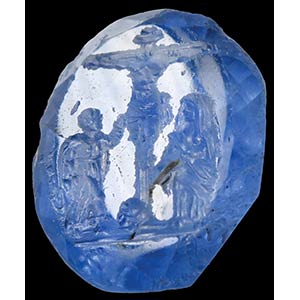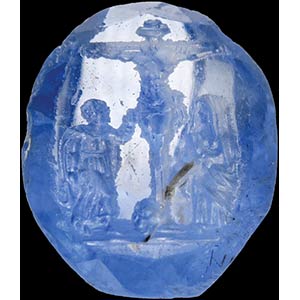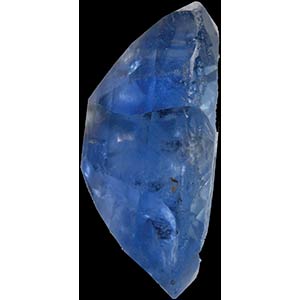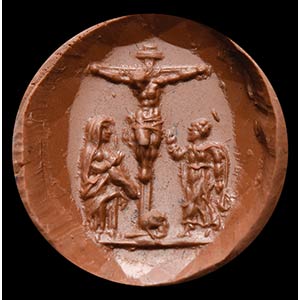
- Home
- Аукционы открытые
-
Аукционы закрытые
- Coins & Medals
- Philately
- Antiquities
- Old Masters
- Jewellery, Silver, Watches
- Ancient and Modern Glyptic
- Ancient Porcelains and Ceramics
- Antiques
- Modern & Contemporary Art
- 20th Century Design and Decorative Arts
- Prints and Multiples
- Asian and Tribal Art
- Photography
- Medieval Art
- Ancient Frames
- Fashion, Textiles & Luxury
- Books, Autographs and Memorabilia
- Wines and spirits
- Oddities, Curiosities & Wonders
- Info
- Live Auction
- Home
- Auction 54
- 313 An important sapphire intaglio. Italy, Milan, third ...
Лот 313 - Auction 54
Описание
Affixed to the top of the vertical pole of the cross is a rectangular plate. Flanking the central scene are, on the right, the caped Virgin, veiled and with her hands joined in prayer, and to the left, St. John the Evangelist, wearing a belted garment and cape. He raises his right hand towards Christ. At the foot of the cross, a skull, symbolizing memento mori (Calvario). There is a ground line.
The body of Christ is finely detailed, with the major muscles deeply carved. The religious language of the Calvary scene, as given by the Gospel of St. John, is here depicted in the dialogue between the dying Christ, his favourite apostle and the Virgin.
The engraving has been carried out with brilliant flair and great technical competence, considering the very small surface available and the extreme hardness of sapphire.
The gem, of an intense blue color, is enhanced by faceting, both framing the engraved surface, and the back. The choice of engraving this highly meaningful iconography on sapphire is not accidental, as only the highest members of the Church hierarchy were entitled to wear this gem. Considering when and where the intaglio was cut, and following exhaustive study of the sources combined with an analysis of coeval portraiture, it is highly likely that this gem – no doubt originally mounted in a gold ring - was the personal seal of Cardinal and Archbishop Carlo Borromeo (1538-1584), a key-figure of the Counter Reformation of the Roman Catholic Church.
Born to two prominent Lombard banking families (Medici and the Counts of Arona), he was always destined for a prominent public role in Lombard society. As he was not the first-born male, his destiny was, in accordance with traditions in noble families at that time, to enter the priesthood.
In 1545, when he was just seven, he received the tonsure, the priest’s robes, and his first ecclesiastical title, which would later be followed by many others. After receiving his doctorate in civil and canon law in 1559 and following the election of his uncle Cardinal Angelo Medici as Pope Pius VI in the same year, he was summoned to Rome where he was appointed bishop in the Sistine Chapel by Cardinal Giovanni Serbelloni. Three weeks later his uncle raised him to cardinal. He was formally appointed archbishop of Milan in May 1564 and moved there in 1565 with a retinue of 100 people. His task was to run a diocese with authority over another 15 archbishoprics in Lombardy, Piedmont and Liguria.
It is more than likely that on one of these occasions he was given the blue sapphire that was considered the preserve of archbishops and the highest ranks of church officials. These gems provide visual evidence for the then prevailing belief here expressed by the German Andreas Jessner, that:
One should wear blue sapphire chastely to remain healthy for a long time.
That chastity always remained an issue is clear also from the writings of the Dutch theologian Gerrit Janszoon Vossius (1577–1649), who wrote:
sapphire worn in a ring or in any other manner is able to quench concupiscence, and for that reason is proper to be worn by the priesthood and by all persons vowed to perpetual chastity.
Borromeo is shown wearing just such a ring set with a sapphire on a painting by Samaritana Samaritani, now in the Gallery Poveri Vergognosi, Bologna. A second picture of Carlo Borromeo by Bizzozzero Ottavio, currently in the art collection of Hospedale Maggiore, Milan, likewise shows the prelate wearing a sapphire ring.
Arriving in Rome, Borromeo loved society life, hunting, banquets, chess, and humanistic culture. However, following the sudden death of his brother, Federico in 1562, Carlo resolved to follow a particularly frugal Christian lifestyle. He organized the third Council of Trent (1562-3) that codified this austere lifestyle for other entrants to the priesthood.
Throughout his life he emphasized the importance of education for candidates for holy orders and priesthood. He established seminaries and colleges (The Almo Collegio Borromeo in Pavia still exists today). In 1576, following drought and famine, the plague broke out in Milan, and Borromeo spent all of his private fortune to try and feed the more than 60,000 people in desperate need. He personally cared for the sick in the “Lazzarettos,” the areas in which those suffering from the disease were segregated. After his death, in 1584, Pope Clement VIII beatified Carlo in 1602. On November 1, 1610, Carlo Borromeo was canonized by Pope Paul V.
References:
For an early Byzantine prototype cf.: Papanikola-Bakirtzi, D., (ed.) Everyday Life in Byzantium. Athens, 2002.. p. 485, n. 659, 6th-7th c.
For two Middle Byzantine prototypes, cf.: Spier, J. Middle Byzantine (10th-13th century AD) stamp seals in semi-precious stone. p. 114- 126, n. 14-17 and 14-18 in: Entwistle, C. Through a Glass Brightly; Studies in Byzantine and Medieval Art and Archaeology Presented to David Buckton. London, 2003.
Then for contemporary parallels: Kris, E. Catalogue of the Postclassical Cameos in the Milton Weil Collection. Vienna, 1932..p. 14, pl. II, cameo, XIV c. (though a somewhat later date cannot be ruled out in my opinion)
Kagan, J. and Neverov, O. Splendeurs des Collections de Catherine II de Russie. Paris, 2000. p. 154. n. 198/14. 2nd half of the XVI c. Dalton, O.M. Catalogue of the Engraved Gems of the Post-Classical Periods…British Museum. London, 1915. p. 81, pl. XX - n. 567.
12.8 x 10x 5 mm; peso 6.9 carati
Используйте форму для регистрации или введите логин в правой части формы.
За дополнительной информацией обращайтесь info@bertolamifineart.com
Категории
Аукцион: Auction 54
 Политика использования файлов cookie
Политика использования файлов cookie
Этот сайт использует файлы cookie для улучшения взаимодействия с пользователем и сбора информации об использовании сайта. Существуют также файлы cookie, которые можно использовать для выбора персонализированной рекламы и рекламного контента. Вы можете ознакомиться с нашей политикой использования файлов cookie, принять все файлы cookie и продолжить просмотра, нажав "Принять" или измените свой выбор, нажав "Настроить".
Политика использования файлов cookie
Файлы cookie
Чтобы этот сайт работал должным образом, мы иногда устанавливаем на ваше устройство небольшие файлы данных, называемые " cookie ". Большинство крупных сайтов делают то же самое.
Что такое файлы cookie?
Файл cookie - это небольшой текстовый файл, который веб-сайты сохраняют на вашем компьютере или мобильном устройстве во время их посещения. Благодаря файлам cookie сайт запоминает ваши действия и предпочтения (например, логин, язык, размер шрифта и другие параметры отображения), чтобы вам не приходилось повторно вводить их, когда вы возвращаетесь на сайт или переходите с одной страницы на другую.
Как мы используем файлы cookie?
Сторонние файлы cookie
Google Analytics
Этот сайт использует Google Analytics для сбора информации об использовании пользователями его веб-сайта. Google Analytics генерирует статистическую и другую информацию с помощью файлов cookie, хранящихся на компьютерах пользователей. Информация, полученная в отношении нашего веб-сайта, используется для составления отчетов об использовании веб-сайтов. Google будет хранить и использовать эту информацию. Политика конфиденциальности Google доступна по следующему адресу: https://policies.google.com/privacy .
Для работы сайта не обязательно включать файлы cookie, но это улучшает навигацию. Можно удалить или заблокировать файлы cookie, но в этом случае некоторые функции сайта могут работать некорректно.Информация о файлах cookie не используется для идентификации пользователей, и данные навигации всегда находятся под нашим контролем. Эти файлы cookie используются исключительно для целей, описанных здесь.
Как контролировать и изменять файлы cookie?
Вы можете изменить или отозвать свое согласие в любое время в декларации файлов cookie на наш сайт.
Политика конфиденциальности
Узнайте больше о том, кто мы такие, как вы можете связаться с нами и как мы обрабатываем личные данные, в нашем политика конфиденциальности .
Необходимые файлы cookie помогают сделать веб-сайт пригодным для использования за счет включения основных функций, таких как навигация по страницам и доступ к защищенным областям сайта. Веб-сайт не может нормально функционировать без этих файлов cookie.
| Имя | Поставщик | Цель | Срок действия |
|---|---|---|---|
| cookieConsent | Bid Inside | Сохраняет статус согласия пользователя на cookie для текущего домена | 6 месяцев |
| PHPSESSID | Bid Inside | Сохранять статус пользователя на разных страницах сайта. | Когда сеанс просмотра заканчивается |
| f_display | Bid Inside | Файлы cookie f_display запоминают режим отображения, выбранный пользователем на страницах, где есть списки. | Когда сеанс просмотра заканчивается |
| f_page | Bid Inside | Файлы cookie f_page хранят страницу, просмотренную пользователем, на страницах, где есть списки. | Когда сеанс просмотра заканчивается |
| f_rec_page | Bid Inside | Файлы cookie f_rec_page хранят количество элементов, которые должны отображаться на странице, выбранной пользователем на страницах, на которых есть списки. | Когда сеанс просмотра заканчивается |
| f_order_by | Bid Inside | Файлы cookie f_order_by хранят выбранный пользователем параметр сортировки на страницах, где есть списки. | Когда сеанс просмотра заканчивается |
| f_order_dir | Bid Inside | Файлы cookie f_order_dir хранят направление упорядочивания, выбранное пользователем на страницах, где есть списки. | Когда сеанс просмотра заканчивается |
| watch_list_show_imgs | Bid Inside | Файл cookie watch_list_show_imgs хранит выбор пользователя, отображать или скрывать изображения лотов на странице списка наблюдения | Когда сеанс просмотра заканчивается |
| selected_voice | Bid Inside | В файле cookie selected_voice хранится голос, выбранный пользователем для синтеза речи, присутствующий на живом аукционе | 1 Месяц |
| include_autobids | Bid Inside | Файл cookie include_autobids сохраняет выбор пользователя — показывать или скрывать свои auto-bid на странице «Ваши ставки». | 6 месяцев |
Аналитические файлы cookie помогают понять, как посетители взаимодействуют с веб-сайтом, собирая и передавая статистическую информацию контроллеру данных.
| Имя | Поставщик | Цель | Срок действия |
|---|---|---|---|
| _ga | Зарегистрируйте уникальный идентификатор, используемый для генерации статистических данных о том, как посетитель использует веб-сайт. | 2 года | |
| _gat_gtag | Используется Google Analytics для ограничения частоты запросов | 1 день | |
| _gat | Используется Google Analytics для ограничения частоты запросов | 1 день | |
| _gid | Зарегистрируйте уникальный идентификатор, используемый для генерации статистических данных о том, как посетитель использует веб-сайт. | 1 день | |
| __utma | Bid Inside | Используется для различения пользователей и сеансов. Файл cookie создается, когда библиотека javascript выполняется, а существующие файлы cookie __utma не существуют. Файл cookie обновляется каждый раз, когда данные отправляются в Google Analytics. | 2 годы |
| __utmt | Bid Inside | Используется для ограничения скорости запросов. | 10 минут |
| __utmb | Bid Inside | Используется для определения новых сеансов / посещений. Файл cookie создается, когда библиотека javascript выполняется, а существующие файлы cookie __utmb не существуют. Файл cookie обновляется каждый раз, когда данные отправляются в Google Analytics. | 30 минут |
| __utmc | Bid Inside | Не используется в ga.js. Набор для взаимодействия с urchin.js. Исторически этот файл cookie работал вместе с файлом cookie __utmb, чтобы определить, был ли пользователь в новом сеансе / посещении. | Когда сеанс просмотра заканчивается |
| __utmz | Bid Inside | Сохраняет источник трафика или кампанию, объясняющую, как пользователь попал на ваш сайт. Файл cookie создается при запуске библиотеки javascript и обновляется каждый раз, когда данные отправляются в Google Analytics. | 6 месяцы |
| __utmv | Bid Inside | Используется для хранения данных пользовательских переменных на уровне посетителя. Этот файл cookie создается, когда разработчик использует метод _setCustomVar с настраиваемой переменной уровня посетителя. Этот файл cookie также использовался для устаревшего метода _setVar. Файл cookie обновляется каждый раз, когда данные отправляются в Google Analytics. | 2 годы |
Предпочтительные / технические файлы cookie позволяют веб-сайту запоминать информацию, которая влияет на то, как сайт ведет себя или представляет себя, например, ваш предпочтительный язык или регион, в котором вы находитесь.
Мы не используем файлы cookie этого типа.Профилирующие файлы cookie используются в маркетинговых целях для отслеживания посетителей веб-сайта. Их цель - отображать релевантную и привлекательную рекламу для отдельного пользователя.
| Имя | Поставщик | Цель | Срок действия |
|---|---|---|---|
| _fbp | 6 months | ||
Неклассифицированные файлы cookie - это файлы cookie, которые классифицируются вместе с отдельными поставщиками файлов cookie.
Мы не используем файлы cookie этого типа.











 314
314